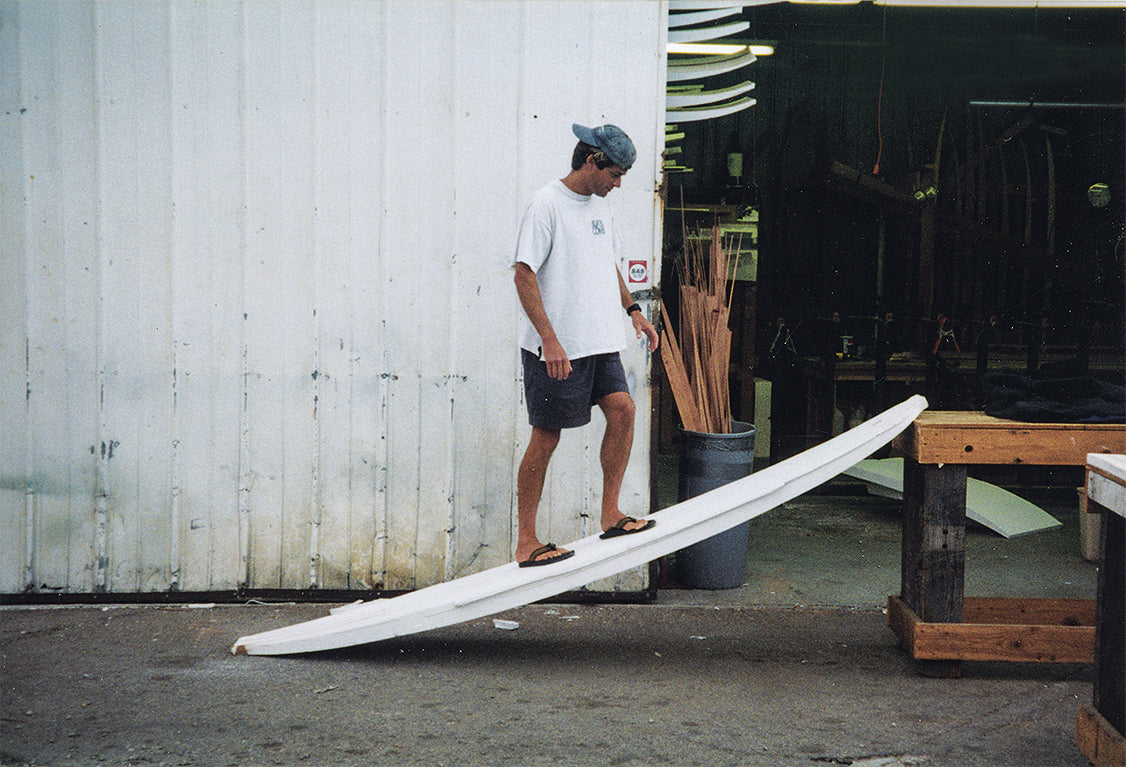After watching Foam Dust, the film celebrating 25 years of Fletcher Chouinard Designs, the casual viewer may walk away – if it’s possible – actually knowing less about Fletcher Chouinard as a result. This is Fletch’s style. While his name might be on the surfboards produced from the FCD factory in Ventura, Fletch remains supremely underground, and as someone quips in the film, “a conundrum wrapped in a riddle.” Sammy Cammack from the glass shop – laminating guru, Puerto charger, long-time FCD employee – still can’t believe that his boss, after all these years, has managed to keep such a low profile. “We’re just tripping that people still don’t know who Fletch is, maaaaaaan!”
Just like his father, Yvon who became a “reluctant businessman” as his company, Patagonia grew into a global enterprise, Fletcher Chouinard shuns any kind of spotlight. He might even be better at the ‘reluctant’ part than his dad and manages to maintain some heavy mysto vibes throughout a movie dedicated to him and his boards. “I just like to build things and hide,” is how he sums it up.
While his fingerprints might be on the boards coming out of the Ventura factory, the FCD story is far bigger than Fletch himself. It’s a long story about trial and error, and a big idea that sat at odds with an industry increasingly calibrated to mass produce to a mass market. From the start, the great rolling experiment that in time became FCD surfboards was driven by the simple idea of making surfboards that would last.
A simple idea that, as it turned out, hasn’t proved that simple to pull off.
Starting initially as Skunkworks, then becoming Point Blanks and ultimately FCD, the unicorn idea driving the whole show for 25 years has been making a high performance, durable surfboard. As Jason McCaffrey – Skunkworks’ first employee – explains, the boards at the time were a response to, “the industry pumping out breakable boards, breakable trunks. Just image-based nonsense.”
Foam Dust documents the subsequent journey down the rabbit hole of two decades of R&D and backyard experimentation – new foam, new blanks, new designs – all with varying levels of success. None of this was conducted in sterile, white-light environments, but a tin shed at the far end of the Patagonia lot, under a highway overpass. And none of it was done by material scientists, instead by Fletch’s surf bum mates, some of whom lived in the car park out the back, and all of whom would disappear at the slightest hint of any swell. “We were like basically homeless people who worked for Yvon that didn’t work for Patagonia and nobody knew any of us,” is how McCaffrey remembers it.
At the time, the idea of durable boards swam against the tide. As the pop-out era dawned and surfboard production was increasingly being offshored, work continued in the tin shed in Ventura with alternative materials and processes… and moderate success. The boards lasted longer, but they didn’t look like the slick, production shortboards being pumped out elsewhere. They had round noses, were heavier, and at a time surfboards were homogenising they looked like nothing else on the market. The result? The whole operation at one point almost went under, being reduced at one stage to, as someone put it in the film, “three boneheads on a dead-end street.”
“That’s what was so interesting,” offers FCD’s Ben Lemke. “They’re out there trying to make magic boards that last rather than just making magic boards. These guys were about selling you less boards, which probably wasn’t the best business plan.”
Described in the film as “YC’s side project”, Yvon Chouinard originally coached the Skunkworks and Point Blanks crew from the sidelines (and the lineup), but never resourced the operation with a bottomless budget, leaving them to their own devices. “There were no handouts and no freebies,” recalls McCaffrey. “He wanted to watch the struggle. We worked for Yvon and nobody knew what we were up to… not even him.”
Eventually they found a groove. Fletcher, who’d started shaping under the purist influence of Dave Parmenter, came on board and the label moved out from Patagonia and started trading under FCD. Between Fletch’s eye for design and an improvement in production values, the label grew. The broad goal however remained the same. “The mission was make a more durable board and get ‘em looking killer,” recalls McCaffrey. “That’s been the project from day one.”





